Search Results for Tag: Sea level
Ice paradoxes from pole to pole
Returning after a longish break with little access to news and data, there are several ice and snow stories jumping out of my mailbox at me. I’ve picked out two which those of a skeptical persuasion might say disprove some key climate assumptions, but which actually, in fact, confirm some trends and predictions.
Worrying, but not unexpected, are the latest measurements of the extent of the Arctic sea ice. In February, the experts at the National Snow and Ice Data Center (NSIDC) based in Boulder, Colorado, noted a record for the lowest observed maximum sea ice extent. Although it seems the sea ice did grow at some points during March, the overall for the month was the lowest recorded since satellite measurements began in 1979. The average extent for the month was 14.39 million square km – some 1.13 million square km below the 1981-2010 long-term average. The previous March low of 14.45 million square km was recorded in 2006.
In the Arctic Journal, Kevin McGwin quotes Andy Mahoney, a geophycisist with the Sea Ice Group at the University of Alaska Fairbanks, as saying the irregular pattern, with a kind of “double dip”, with the ice decreasing, increasing, then decreasing again, is “a pretty unusual event, regardless of the reason”. Normally, the ice levels would increase to the seasonal maximum first in March, then decline.
One reason, Mahoney says, could be the wind blowing ice into the regions where ice growth was observed, according to the NDSIC the Bering Sea, Davis Strait and around Labrador.
No contradiction to climate warming theory
The NSDIC says warm conditions in the Bering Sea and the Russian Sea of Okhotsk contributed to the record low winter ice maximum.
The overall downward trajectory, however, is clear. The brief increase in March is not a sign that the sea ice is recovering. Mahoney told the Arctic Journal parts of Alaska had seen abnormally high temperatures this winter, which was in line with the overall seasonal ice observations.
“What drives the maximum extent is what happens at the margins, and they can grow and retreat due to short-term variants. The conditions in the central Arctic, far from the action, are indicative of the warm year we’ve had in Alaska,” he said. Barrow, on Alaska’s northern coast, far away from the southern margin, for example, saw a lot of broken ice this winter, according to Maloney.
WWF expressed concerned about the latest figures:
“This is not a record to be proud of. Low sea ice can create a series of reactions that further threaten the Arctic and the rest of the globe,” said Alexander Shestakov, Director, WWF Global Arctic Programme.
“This chilling news from the Arctic should be a wakeup call for all of us,” said Samantha Smith, the leader of WWF’s Global Climate and Energy Initiative. She stresses the need to cut global emissions to halt the Arctic melt.
The proportion of thick Arctic ice that lasts multiple years has dwindled over the past two decades. A recent study shows that Arctic sea ice has thinned by 65 per cent since 1975, leaving ice that is more susceptible to melting.
Writing for Alaska Dispatch News (AND), Yereth Rosen notes that the most dramatic changes in the Arctic sea ice extent have been in the melt season, not in the period of maximum winter coverage. He quotes NSIDC scientist Julienne Strove, who led a study published last year in Geophysical Research Letters which showed the open-water season is lengthening, mostly because of extended melt in summer and autumn. So is this additional winter record a sign of more melting to come? Only time will tell, but the signs are not looking good.
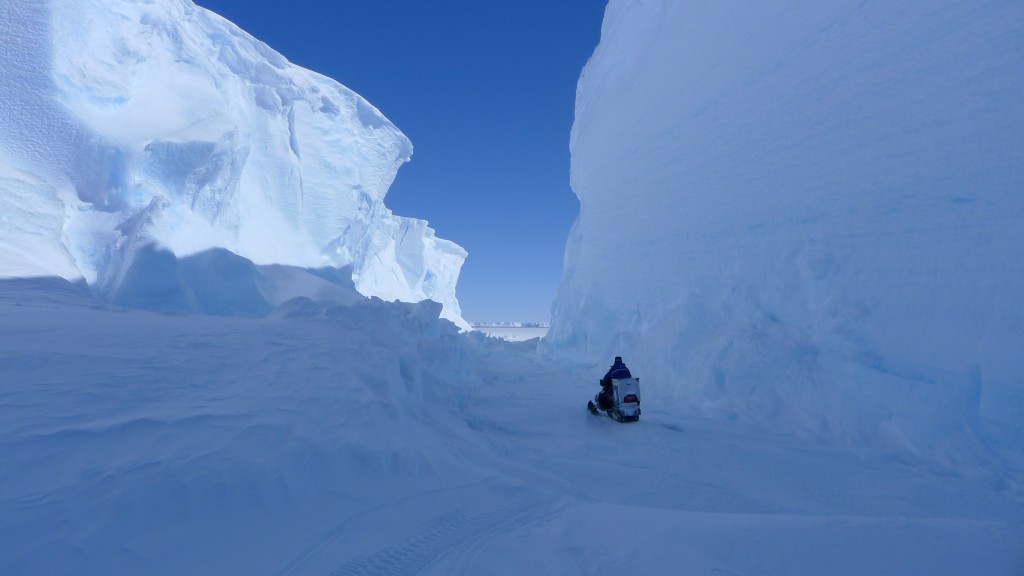
Warmer temperatures, more snow? Belgian International Polar Foundation shot of director and explorer Alain Hubert in the Antarctic.
A story from the opposite pole has also attracted attention. It says climate change is actually increasing the amount of snow in the Antarctic. Puzzling? Not necessarily.
More heat, more snow?
An international study headed by Germany’s Potsdam Institute for Climate Impact research (PIK) comes to the conclusion that every degree of regional warming could increase snowfall there by around five percent. The estimate is based on ice cores and climate modeling.
The information adds a new element to calculations of how much the Antarctic will contribute to global sea level rise. Some people might assume more snow would stop the Antarctic from losing mass. In fact the increasing weight of new snow and ice can make it slide towards the coast and into the ocean faster. In this connection, you might like to read some more stories on these Antarctic issues:
Thicker-ice-in-the-antarctic-good-news-for-the-climate?
Antarctic melt could raise sea levels faster
West Antarctic ice sheet collapse unstoppable
Anders Levermann, one of the new study authors, whom I have spoken to several times on the effects of climate change on the Antarctic and global sea levels, says the latest results back up earlier conclusions that the Antarctic will lose more ice than it will gain and thus have a major influence on global sea level. Levermann, from PIK, is also one of the lead authors of the sea-level chapter of the IPCC report. He stresses that the latest study just provides yet another piece of the “jigsaw puzzle” coming together on how global sea level is likely to develop in the future.
If the world leaders called on to come up with a new world climate agreement at the end of this year need any more motivation, this scientific research from both ends of the world should really give them an extra push.
The Arctic on the UN agenda
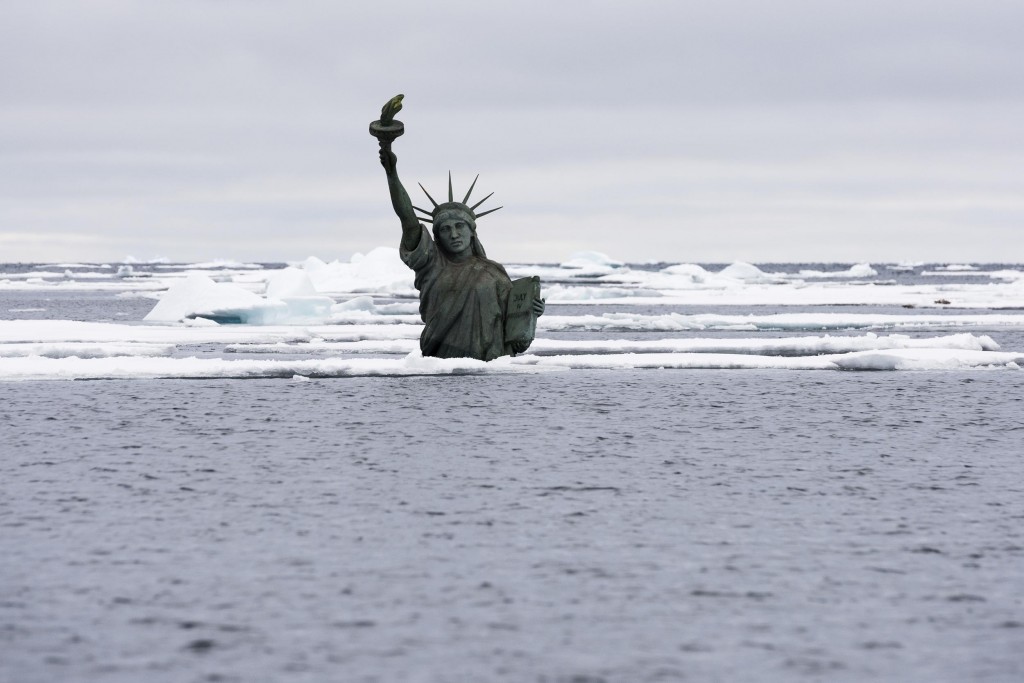
US icon sinking in melting ice? The photo was taken in the Arctic Ocean northwest of Svalbard the 7th of September 2014.
(Christian Auslund / Greenpeace)
To those of us who deal with the Arctic on a regular basis, the significance of the melting ice for the UN climate negotiations and vice versa is abundantly clear. But not everybody understands all the connections. A major media event like this week’s New York climate summit hosted by the UN Secretary General Ban Ki Moon in person was a fine chance to focus attention on the need to protect the Arctic. Greenpeace made good use of it, handing over a petition with six million signatures just ahead of the big event, and with hundreds of thousands gathered in New York for the Climate March.
It was timely in more ways than one, just as the latest sea ice figures were published to confirm the melting trend.
The petition calls for long-term protection of the Arctic, with the region warming more than twice as fast as the global average and opening the high north to shipping and commercial exploitation. Greenpeace and other groups are calling for a ban on oil exploration, which could endanger the fragile ecosystem. Experts also have safety concerns about increased shipping.
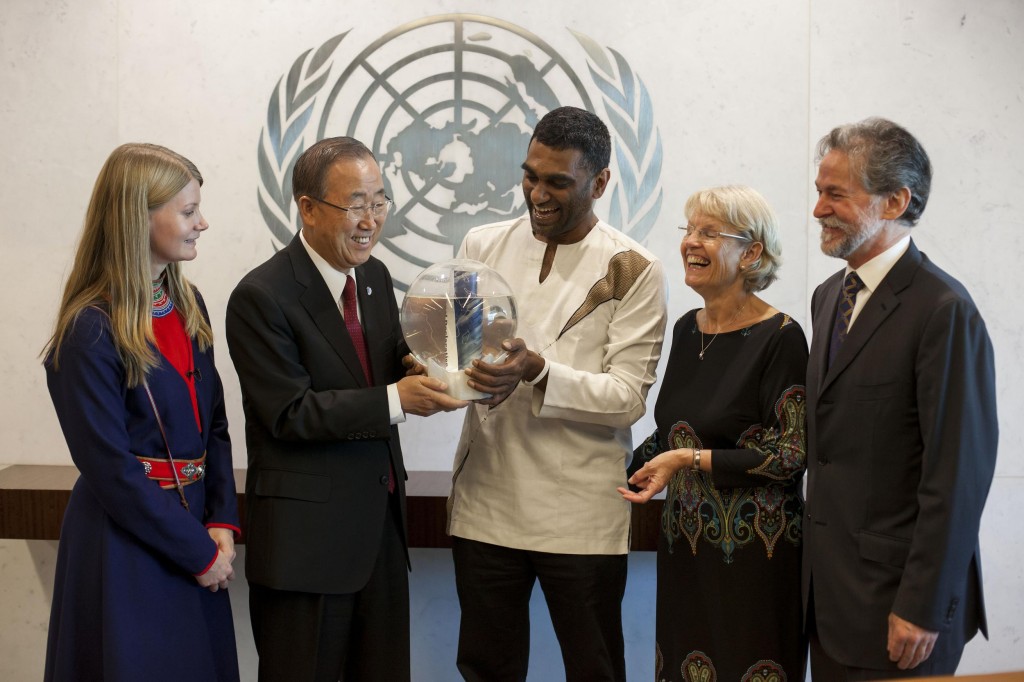
Ban Ki-moon receives the Greenpeace delegation with the petition. The delegation consists of Indigenous rights activist, youth leader and Saami politician Josefina Skerk, Margareta Malmgren-Koller, Greenpeace Senior Political Advisor Neil Hamilton and Greenpeace International Executive Director Kumi Naidoo. Photo: Michael Nagle / Greenpeace
Commercial development versus environment
Earlier this month, a survey showed that 74% of people in 30 countries support the creation of a protected Arctic Sanctuary in the international waters surrounding the North Pole. The study was commissioned by Greenpeace and carried out by Canadian company, RIWI. Around the same time, the Arctic Council, which combines the Arctic states and indigenous peoples’ representatives, currently chaired by Canada, supported the founding of a new business grouping, the Arctic Economic Council. Its aim is to promote the commercial development of the Arctic region. I wrote about this here on the Ice Blog and on the DW website.
Global responsibility for the Arctic
The UN Secretary General accepted the Greenpeace petition saying:
“I receive this as a common commitment toward our common future, protecting our environment, not only in the Arctic, but all over the world.”
Ban Ki-moon said he would consider convening an international summit to discuss the issue of Arctic protection. He also expressed a desire to travel aboard one of the organisation’s campaigning ships in the Arctic in the near future.
Greenpeace Executive Director Kumi Naidoo, who was part of the delegation, said: “The Arctic represents a defining test for those attending the summit in New York”.
He said leaders should bear in mind that concern for the rapid warming of the world was not consistent with planning oil and gas development in the melting Arctic.
The small delegation that met Ban Ki Moon included Indigenous rights activist and Saami politician Josefina Skerk, who last year trekked to the North Pole to declare the top of the world ‘the common heritage of everyone on earth’.
Skerk, a member of the Saami Parliament, said: “We, who want to continue living in the North, are gravely concerned about climate change and the destructive industries that are closing in. My people know and understand the Arctic, and it is changing in a manner, which threatens not just our survival, but the survival of people all over the world.”
Skerk said humans had created the crisis and had to take action to solve it.
“I urge the Arctic countries in particular to take a giant step up and I think the world needs to pay much closer attention to ensure that it happens. They might as well start here in New York.”
From Kiribati to Svalbard and New York
Melting ice especially from the Arctic Greenland ice sheet is raising sea levels around the globe, endangering low-lying areas. At the weekend, the President of Kiribati, Anote Tong, ended a Greenpeace-organized tour of glaciers in Norway’s Svalbard Archipelago. He said the trip to the Arctic ice had made a deep impression on him, which he would share with world leaders at the U.N. climate summit:
“It’s a very fascinating sight. In spite of that, what I feel very deeply is the sense of threat,” Tong said. “If all of that ice would disappear, it would end up eroding our shores.”
Kiribati is a group of 33 coral atolls located about halfway between Hawaii and Australia. Many of its atolls rise just a few feet above sea level.
In last year’s report by the Intergovernmental Panel on Climate Change (IPCC), experts concluded oceans could rise by as much as 1 meter (3.3 feet) by the end of this century if no action is taken to cut the greenhouse gas emissions causing global warming.
“It won’t take a lot of sea level rise to affect our islands,” Tong said. “We are already having problems.”
Sea ice minimum confirms melting trend
The New York summit coincides with the annual announcement of the minimum sea ice for the year, as the summer season comes to an end. The sea ice – in contrast to glaciers on land – does not influence global sea level, but is regarded as a key indicator of how climate change is affecting the region. This year the figure announced by the US National Snow and Ice Data Centre (NSIDC) was 5.01 million square kilometers. The figure is the sixth lowest extent since records began.
The minimum ever recorded at the North Pole was 3.29m sq km in 2012 – and the eight lowest years have been the last eight years.
Ice levels in the Arctic have recovered from their all-time low, but are still on a shrinking trend, said Julienne Stroeve of the National Snow and Ice Data Centre. ”We have been telling this story for a long time, and we are still telling it,” she said.
NSIDC records showed that, this year, ice momentarily dipped below 5million sq km to 4.98m on 16 September, but the official figure is taken from a five day average.
Satellite data shows that one part of the Laptev Sea was completely clear from sea ice for the first time this summer. One of the most important questions for climate scientists is how soon the Arctic will experience its first sea ice-free summer.
Rod Downie, head of WWF UK’s polar programme, said that this year’s new Arctic minimum should prompt new action from the leaders meeting in New York. He stressed the connection between the Arctic and weather conditions in other parts of the world:
“As David Cameron prepares to meet other global leaders at the UN climate change summit in New York, the increased frequency of extreme weather that is predicted for the UK as a result of a warming Arctic should serve as a reminder that we need urgent action now to tackle climate change,” he said.
The summit was a major PR event to draw attention to the need for urgent and substantial climate action. The accompanying protests around the globe show people are not happy with the slow pace of the climate talks and their governments’ efforts to reduce emissions. Of course there was little in the way of concrete pledges. Still, on the whole, I see it as a successful step on the way to a new climate agreement because it has put the spotlight on climate change at a time where international conflicts are dominating the news agenda.
More commentary on the summit from me here:
World leaders must act as climate takes centre stage
All-star gala puts climate back on the agenda
Polar Ice at UN Bonn Climate Talks

… And the ice continues to melt. (Pic: I. Quaile)
The delegates to the UN climate meeting currently taking place here in Bonn are receiving an urgent appeal from polar scientists to cut emissions to slow polar ice melt and give low-lying coastal regions more time to adapt to rising sea levels.
I was very interested to hear about a side-event being held here this evening, at which the authors of this year’s key studies on developments in the Antarctic will be explaining the connections between melting polar ice and climate change impacts like rising seas, affecting regions as diverse as small island states, Bangladesh or Florida in the USA.
I interviewed Anders Levermann from PIK, the Potsdam Institute for Climate Impacts Research and Pam Pearson, Director of ICCI, the International Cryosphere Climate Initiative, both in Bonn for the event.
The ICCI decided to bring the cryosphere into the Bonn talks to sensitize delegates to the dramatic developments in the Antarctic in particular, says Pearson. Ice Blog readers (and I was so delighted to hear Pam herself is one!) will remember posts earlier this year on melting in the East and West Antarctic. I also covered these in articles for DW. The shocking thing is that the Antarctic, even East Antarctica, which was until relatively recently considered so cold it had to be safe from global warming, is already being affected by climate change. The papers on the West Antarctic even described the melt trend as “irreversible”.
“We have entered an era of irreversible climate change”.
Today, Anders Levermann, author of the East Antarctic paper and one of the world’s leading Antarctic researchers, told me “we have entered a new era of climate change, witnessed the tipping of the West Antarctic ice sheet, and this is irreversible”.
That should really shock people into action, you would think. But climate negotiations are moving, as one of the experts said to me at the meeting “at a glacial pace”. As we can see in Antarctica, though, and Greenland and other regions, those glaciers are speeding up. Maybe there is hope for the climate talks yet!
The announcements by the USA and China on possible emissions cuts have brought a new “buzz” to the Bonn conference. The fact that the key emitters could finally be getting the message and preparing to move, with the impacts of climate change hitting their own countries, has to be a positive signal. Pearson confirmed to me that people in the sunshine state of Florida, where she lives, had become more aware of the importance of melting ice caps with increasing floods and storms.
As Levermann says, Antarctica and Greenland have a huge potential to raise sea level further than previously anticipated. He was lead author on the IPCC report chapter on sea level rise. The latest IPCC report factored in some of the likely impacts from melting ice in these regions for the first time. Of course the latest research was not yet included. For the 21st century forecast, this will not make a lot of difference, says Levermann. But the fact that this irreversible Antarctic melt is now underway will make a big difference to coming generations.
There are those who dispute whether the warming of the ocean, which is causing the Antarctic melt (unlike the surface melt on Greenland) is man-made. Levermann does not rule out natural variation as a possible influence. But ultimately, he says, that is irrelevant. Greenhouse gas emissions and so human interference are warming the planet, and any further warming, whatever the cause, will speed up ice melt. So cutting emissions is the way to slow it down and, Pearson adds, gives people time to adapt to rising seas.
The combination of models based on the principles of physics, using a higher resolution than ever before, and evidence from ice cores showing what happened in the past, make for a high degree of certainty about these ice developments, says Levermann.
“The level of warming will determine the rate with which we discharge West Antarctica, and we can still prevent the tipping of East Antarctica”, the cryosphere experts told us here in Bonn.
That is a huge responsibility. Here’s hoping the message will make it into the hearts and minds of those negotiating the future of the earth’s climate and the governments they represent.
Keeping Greenland in focus
Two interesting publications relating to Greenland caught my eye over the past few days. But it has not proved easy to get them onto the international news agenda. Given the huge importance of the Greenland ice sheet to the planet’s future, this is frustrating to say the least. Fortunately there is the Ice Blog.
The first research relates to a study about the role of ash from fires in bringing about large-scale surface melting. The other predicts Greenland will be a far greater contributor to sea rise than expected.
Let me start with the latter, published in Nature Geoscience. Scientists from the University of California – Irvine and NASA glaciologists have found previously uncharted long deep valleys under the Greenland Ice Sheet. Since these bedrock canyons are well below sea level, they are much more vulnerable to warm ocean waters than previously thought. When warmer Atlantic water hits the fronts of hundreds of glaciers, the edges will erode much further than previously assumed, releasing far greater amounts of water.
Ice melt from the subcontinent has already accelerated, as warmer marine currents have migrated north, the authors say. Older models predicted that once higher ground was reached in a few years, the ocean-induced melting would halt. Greenland’s frozen mass would stop shrinking, and its effect on higher sea waters would be curtailed.
“That turns out to be incorrect. The glaciers of Greenland are likely to retreat faster and farther inland than anticipated – and for much longer – according to this very different topography we’ve discovered beneath the ice,” says lead author Mathieu Morlighem, a UC Irvine associate project scientist, on the university website. “This has major implications, because the glacier melt will contribute much more to rising seas around the globe.”
To obtain the results, Morlighem developed what he says is a breakthrough method that for the first time offers a comprehensive view of Greenland’s entire periphery. It’s nearly impossible to accurately survey at ground level the subcontinent’s rugged, rocky subsurface, which descends as much as 3 miles beneath the thick ice cap.
Since the 1970s, limited ice thickness data has been collected via radar pinging of the boundary between the ice and the bedrock. Along the coastline, though, rough surface ice and pockets of water cluttered the radar sounding, so large swaths of the bed remained invisible.
Measurements of Greenland’s topography have tripled since 2009, thanks to NASA Operation IceBridge flights. But Morlighem says he quickly realized that while that data provided a fuller picture than the earlier radar readings, there were still major gaps between the flight lines.
To reveal the full subterranean landscape, he designed a novel “mass conservation algorithm” that combined the previous ice thickness measurements with information on the velocity and direction of its movement and estimates of snowfall and surface melt.
The difference was dramatic, says Morlighem. What appeared to be shallow glaciers at the very edges of Greenland are actually long, deep fingers stretching more than 100 kilometers (almost 65 miles) inland.
“We anticipate that these results will have a profound and transforming impact on computer models of ice sheet evolution in Greenland in a warming climate,” the researchers conclude.
“Operation IceBridge vastly improved our knowledge of bed topography beneath the Greenland Ice Sheet,” said co-author Eric Rignot of UC Irvine and NASA’s Jet Propulsion Laboratory. “This new study takes a quantum leap at filling the remaining, critical data gaps on the map.”
Other co-authors are Jeremie Mouginot of UC Irvine and Helene Seroussi and Eric Larour of JPL. Funding was provided by NASA.
This is the same team that reported on accelerated glacial melt in West Antarctica, as discussed in an earlier Ice Blog post. Together, the papers “suggest that the globe’s ice sheets will contribute far more to sea level rise than current projections show,” Rignot said.
Indeed. These scientists are telling us the IPCC forecasts were way too low. This could have huge consequences for coastal communities all around the globe.
Unfortunately, a lot of people (even those you would expect to know better) tend to mix up “Arctic” and “Antarctic”. It all goes into the category of “melting ice”, and they think they have heard it all before. What they still don’t realize is that this is something that concerns us all, and that these two polar areas are of huge significance to the world climate as a whole and global sea level. When those two Antarctic studies were released, there was a flurry of news coverage. The challenge for us journalists is how to follow this up and stop the attention curve from dropping.
The other interesting piece of recent Greenland research was conducted by the Dartmouth College Thayer School of Engineering and the Desert Research Institute and reported in the Proceedings of the National Academy of
Sciences. It concludes that ash from Northern hemisphere forest fires combined with rising temperatures to cause large-scale surface melting of the Greenland ice sheet in 1889 and 2012.
The researchers say their findings contradict conventional thinking that the melting was driven by warming alone.
The findings suggest that continued climate change will result in nearly annual widespread melting of the ice sheet’s surface by the year 2100.
Melting in the dry snow region does not contribute to sea level rise, but when the meltwater percolates into the snowpack and refreezes, the surface is less reflective. This reduces the albedo.
Let me give the (almost) last word to the study’s lead author Kaitlin Keegan.
“With both the frequency of forest fires and warmer temperatures predicted to increase with climate change, widespread melt events are likely to happen much more frequently in the future”.
It figures.
Greenland glacier at record speed
I have been working on a story about whether the Arctic infrastructure would be able to cope with a shipping or oil spill accident, which is increasingly likely to occur as development speeds ahead. During the Arctic Frontiers conference in Tromso, I attended an interesting workshop on the topic, where the organisers, the Arctic Institute Center for Circumpolar Security Studies, came to what their experts describe as “worrisome” conclusions. Malte Humpert, Kathrin Keil and Marc Jacobsen presented three incident scenarios involving shipping and oil exploration in the Arctic. Jacobsen’s scenario involved a giant cruise boat with 3000 people on board hitting an iceberg off the West Greenland Coast, near Ilulissat.
In 2009 I was in Ilulissat, working on radio features on climate change in Greenland. This is the Greenland of the tourist brochures, with a constantly changing panorama of icebergs floating past your hotel window – or porthole if you are on a ship. While I was there, the fragility of that beautiful glacier ice was brought home to me.
The Sermeq Kujalleq glacier, also still known by its Danish name “Jakobshavn Isbrae”, is the fastest flowing glacier in Greenland (or Antarctica, these two major ice sources being of key importance to global sea level). The icebergs which create the spectacle floating past the brightly coloured houses of Ilulissat, are breaking off from the glacier. Beautiful to look at, extremely worrying if you think about the background. Back in 2009, scientists were already telling me the glacier was speeding up. Now the latest research published in The Cryosphere (the journal of the European Geosciences Union) confirms that the summer flow of the ice mass has reached a record speed. The scientists, from the University of Washington in Seattle and the German Aerospace Center DLR, say the speeding up in 2013 was 30 to 50 percent higher than previous summers. The scientists analysed satellite images taken every 11 days from early 2009 to spring 2013. Satellite technology plays a key role in observing the ice. Two German radar satellites TerraSAR-X und TanDEM-X provide high resolution data that facilitates precise calculations, according to DLR. One of the authors, Dana Floricioiu from the DLR Earth Observation Center in Oberpfaffenhofen, told journalists it had been striking to see how much the glacier was changing within a very short time.
The researchers found that the glacier’s average speed peaked at 46 metres per day during the summer of 2012. This is the fastest ever recorded for a glacier in Greenland or Antarctica. The big surges take place in summer, but the researchers say the average annual speed of the glacier over the last two years is almost three times what was measured in the 1990s. It is retreating by around 17 kilometres per year. The scientists say these speeds were achieved “as the glacier terminus appears to have retreated to the bottom of an over-deepened basin with a depth of around 1300 m below sea level. The terminus is likely to reach the deepest section of the trough within a few decades, after which it could rapidly retreat to the shallower regions some 50 km farther upstream, potentially by the end of this century”.
The huge volume of ice going into the sea from the Sermeq Kujalleq glacier is already influencing sea level. The glacier drains around 6 percent of the massive Greenland ice sheet Scientists estimate it added about 1 millimetre to global sea levels from 2000 to 2010. The increased speed of the discharge will exacerbate this further.Badnews for people in low-lying coastal areas around the globe. And this is not the only Greenland glacier melting increasingly.
Coming back to the subject of disaster-preparedness – this glacier is thought to be the source of the iceberg that sank the Titanic in 1912. The Arctic Institute’s scenario indicates that an accident like the “Costa Concordia”, which happened in an easily accessible region with no ice or dangerous weather conditions, would have devastating consequences if it happened, say, off the coast of Ilulissat. Search and rescue, accommodation and medical treatment, lack of transport facilities, poor communications infrastructure, no adequate oil spill response technology for icy waters…. food for thought for companies looking to profit from the changing climate of the Arctic – and the governments that should be responsible for protecting humans, wildlife and that beautiful but fragile Arctic ecosystem.



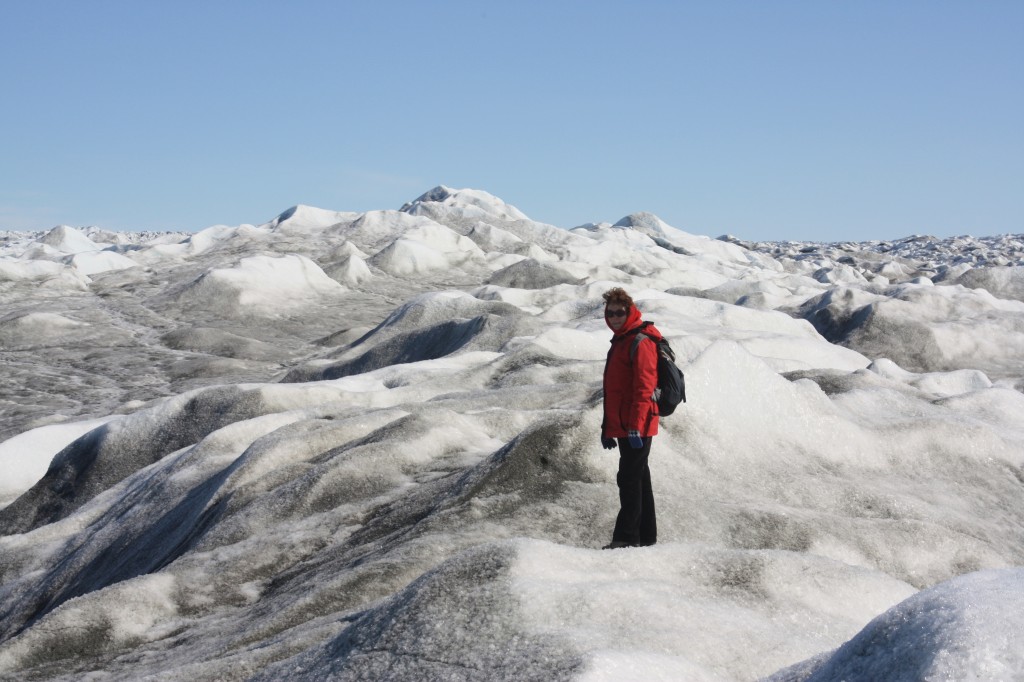




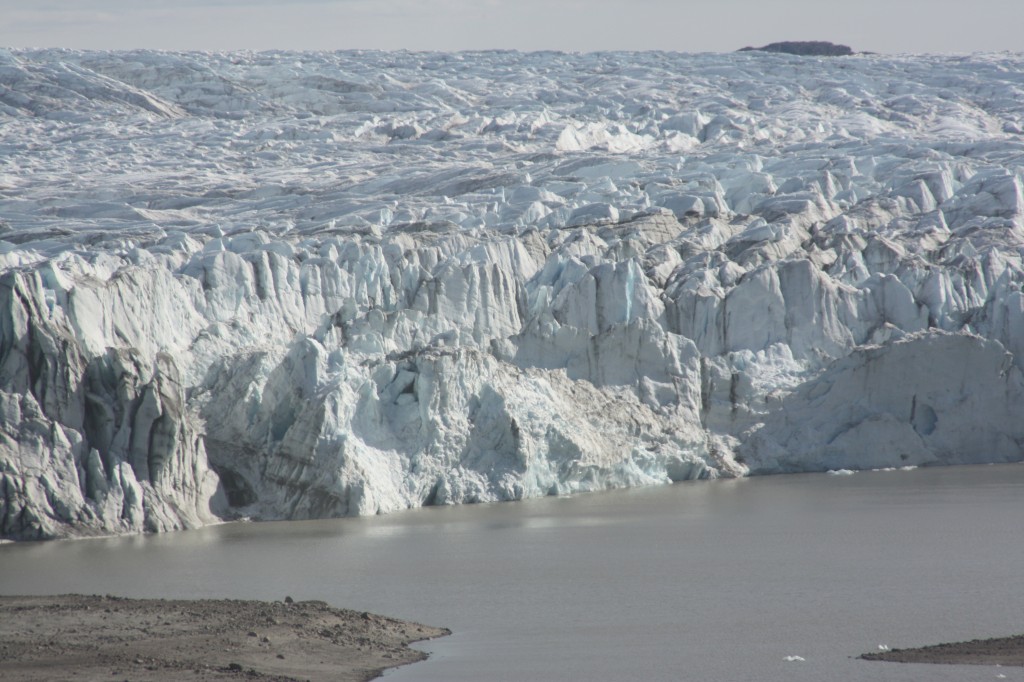
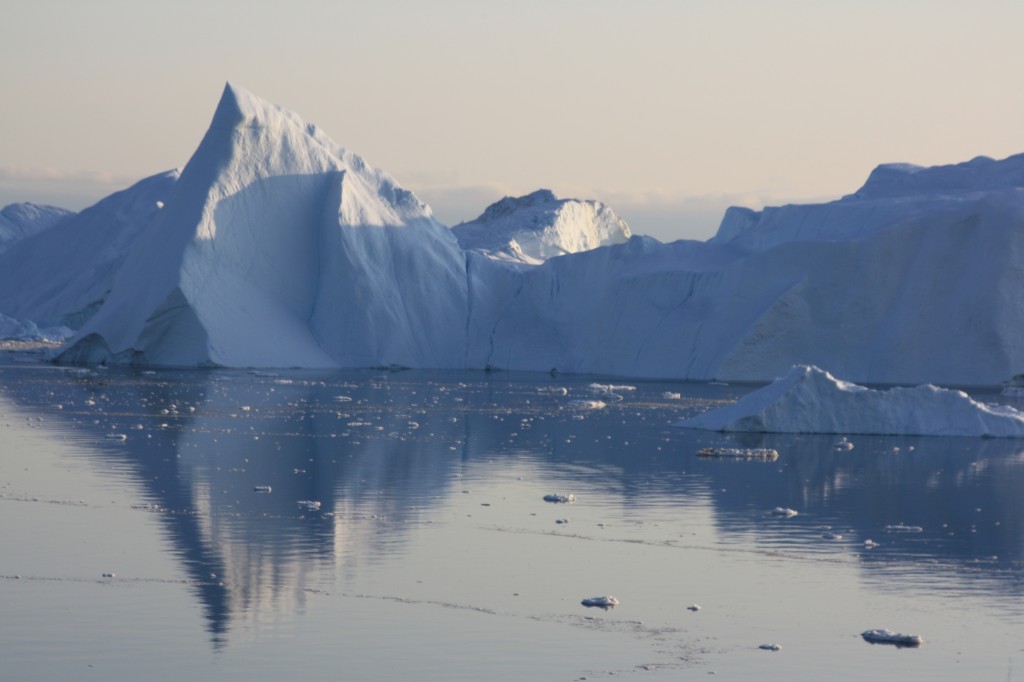
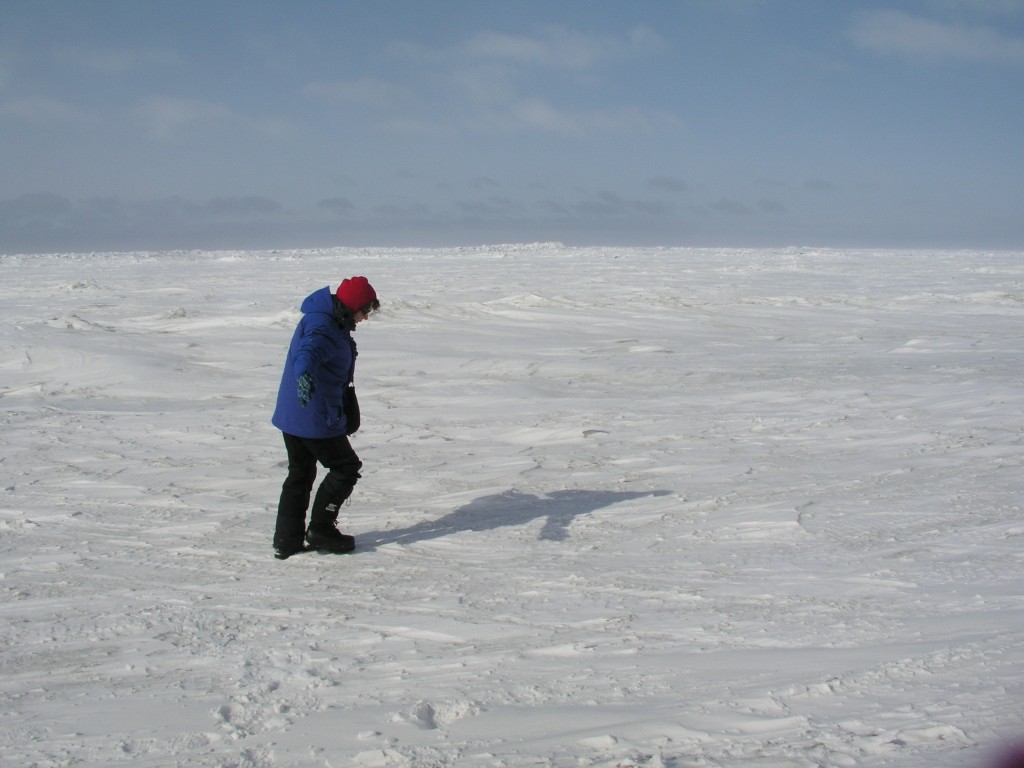
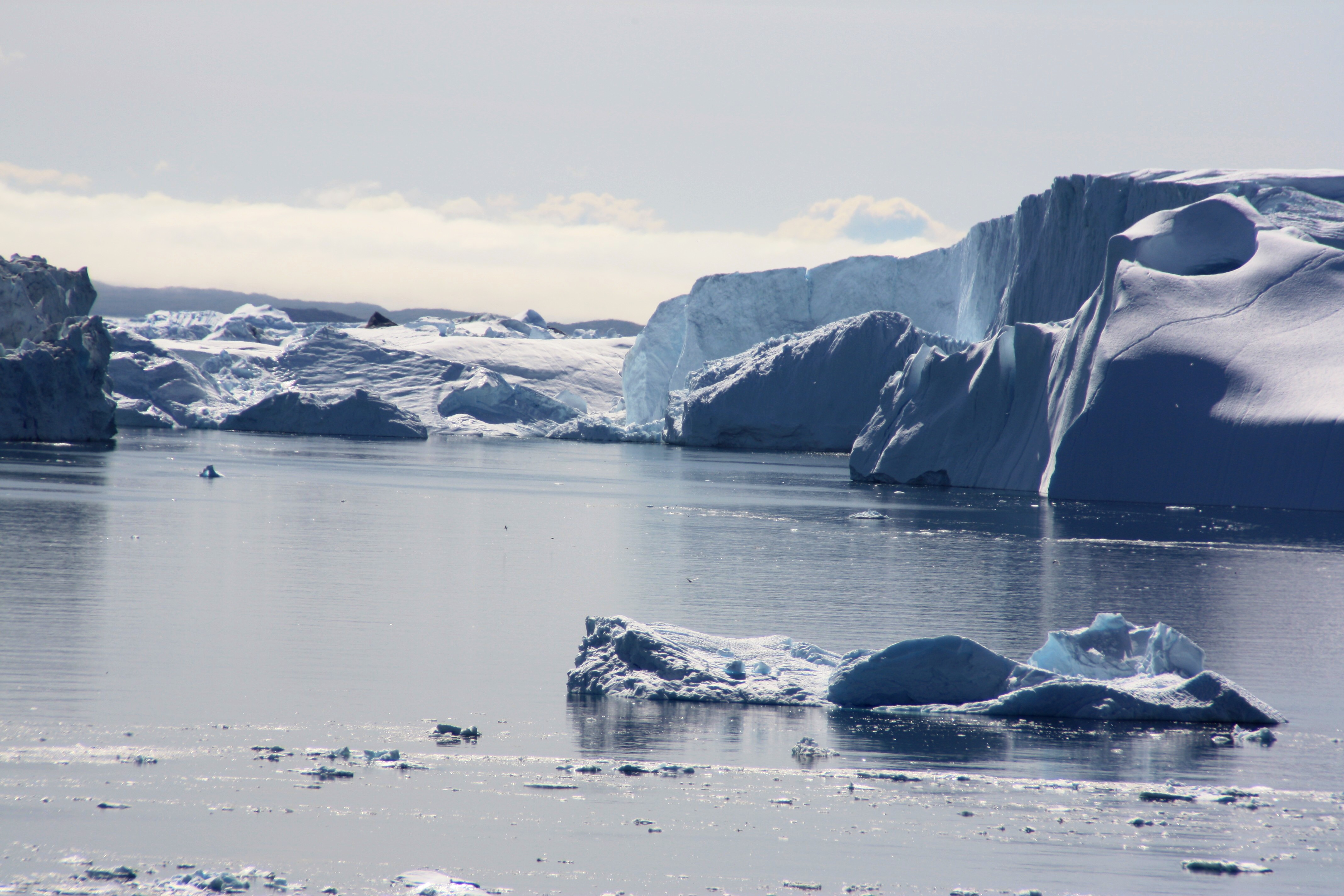
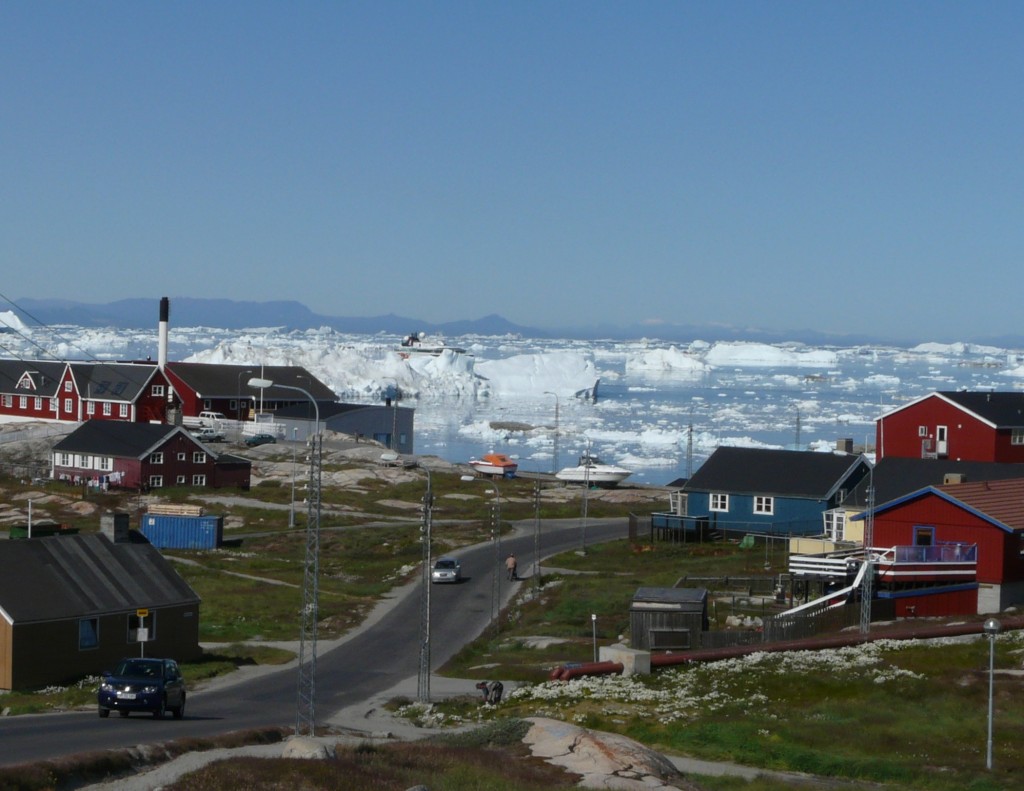
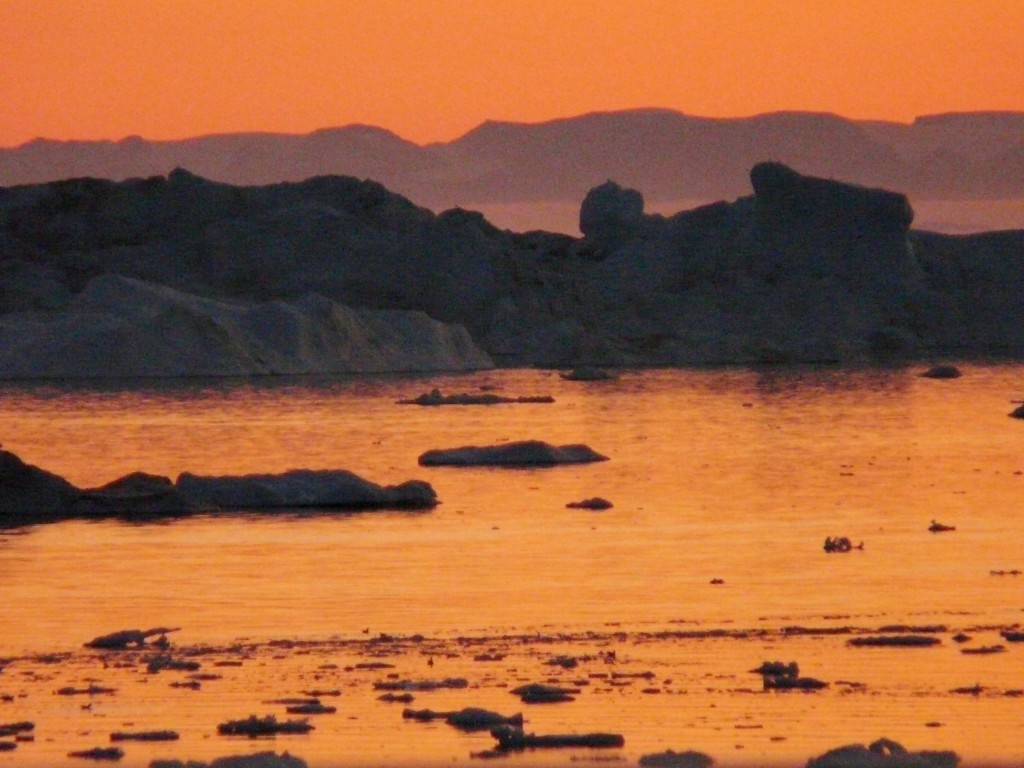
















Feedback